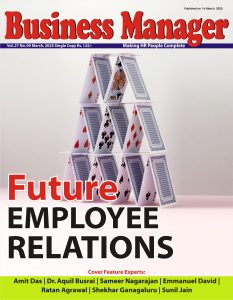Many of the successful organisations in existence today, be that Amazon, Apple or even India’s Flipkart, began from very humble beginnings and believed in the power of smaller teams to step up productivity. In stark contrast, many traditional businesses and organisations still employ a large number of employees, inherently struggling to match the agility of new-age technology companies that are revolutionising the business landscape today. This brings into focus the need for smaller agile teams that work closely together to effect the larger organisational strategy by effectively using technological aids that are gaining ground in a rapidly digitalised world. Let us look at how the human resources (HR) function can put this thought process into practice by embracing HR business tools to survive and thrive in a competitive business environment.
Segregating routine tasks and automating them
It is a well-known fact that HR departments spend significant time on procedural tasks. Functions such as payroll management, attendance and leave management, conducting appraisals and resolving employee grievances form the bulk of their regular workload. With employee satisfaction being one of the most important factors determining the success of an organisation, these tasks ought to be performed with utmost efficiency, speed and attention to detail.
Also read: Sudeep Patnaik joins Everest Group as Vice President – Human Resources
An alternative to the traditional and manual approach is re-organising tasks so they are performed in order of their business importance and consciously shifting towards automating them without the need for human intervention. Many tech-focused platforms are reimagining how HR teams go about achieving this balance by providing automation tools that rely on AI and cloud-delivered functionality that can eliminate the need for human involvement in routine tasks. Organisations that automate their functions with these technologies can reduce repetition and create a lithe HR team that focuses on strategies to drive greater human and business gains.
However, in most cases, these require specialisation, and organisations end up recruiting HR professionals with the requisite experience for these tasks. As a result, these businesses end up having a proportionately large HR team, with many members being required for only specific events or durations.
Automating HR processes to empower employee self-service
With increasing smartphone penetration and a rapidly growing population base that is internet savvy, employees are increasingly preferring web-based or mobile platforms to perform basic HR functions. This includes aspects such as applying for leave, marking daily attendance, or even interacting with other co-workers. With most organisations now adhering to a hybrid working model, it has become even more important to take cognizance of this tectonic shift and provide employees with self-service modules or applications in order to perform HR-related tasks.
Organisations can integrate such functions into their Human Resources Management System (HRMS) and reduce the need for HR team members who would otherwise have to manage them through manual means. In fact, the COVID-19 pandemic has increased the number of companies opting for an advanced HRMS, with most still continuing to engage with their large workforce through online events. Additionally, with powerful web and mobile-based modules for regular tasks, such as leave and attendance management, they can benefit from a smaller HR team for monitoring of operations activities and devote more resources towards the work of greater strategic importance.
Get professional guidance to implement industry best practices
For businesses and organisations that are growing rapidly today, many additional tasks such as managing recruitment and termination of employees, resolving labour conflicts and benchmarking employee benefits also need to be performed by their HR teams and often involve specialisation in line with each firm’s nuanced requirements.
However, in most cases, these require specialisation, and organisations end up recruiting HR professionals with the requisite experience for these tasks. As a result, these businesses end up having a proportionately large HR team, with many members being required for only specific events or durations.
Apart from automation, organisations ought to outsource such non-repetitive requirements to agencies or platforms that have expertise in dealing with them, rather than increasing the HR headcount. Apart from the benefit of a smaller HR workforce, companies would benefit immensely from the knowledge and experience provided by these external entities and be able to implement industry best practices rather than working from the ground up. Not only does this help the HR vertical to remain lean, but it also offers them the opportunity to focus on implementing the various outsourced processes rather than researching or reinventing them.
As organisations change focus to extracting all-round productivity through an engaged workforce, it is clear that the traditional way of working won’t cut it for HR teams as we progress towards a more digitally connected world. Automating routine tasks, augmenting employee self-service functionalities and outsourcing non-repetitive requirements will not only reduce the overall HR team strength but also offer organisations the much-needed agility to navigate through the challenges of a VUCA (volatility, uncertainty, complexity and ambiguity) world.
Stay connected with us on social media platform for instant update click here to join our LinkedIn, Twitter & Facebook























Add comment